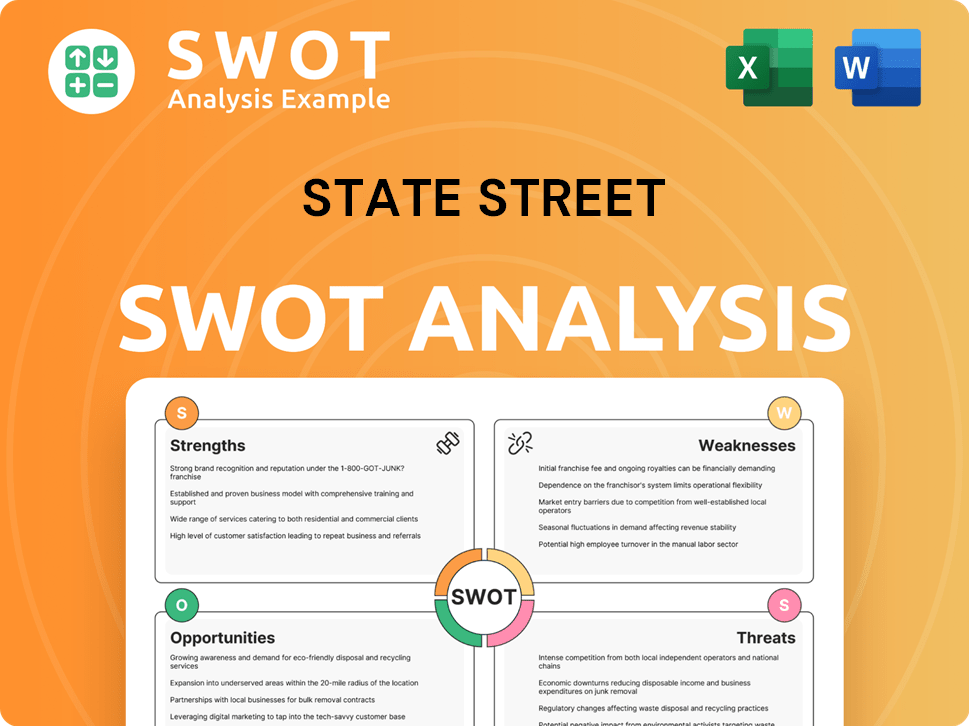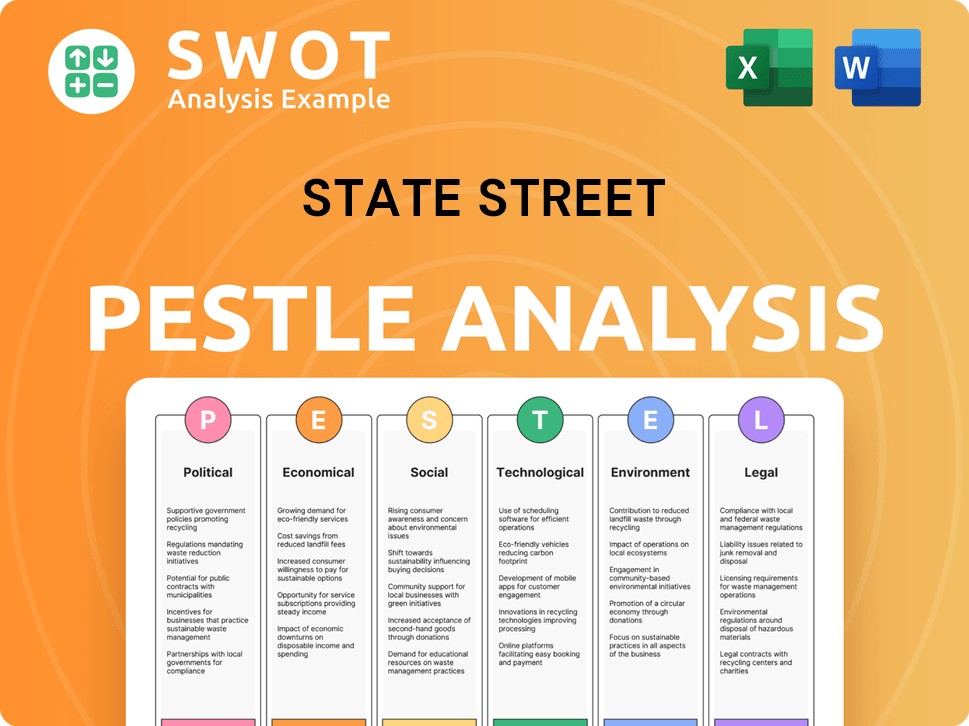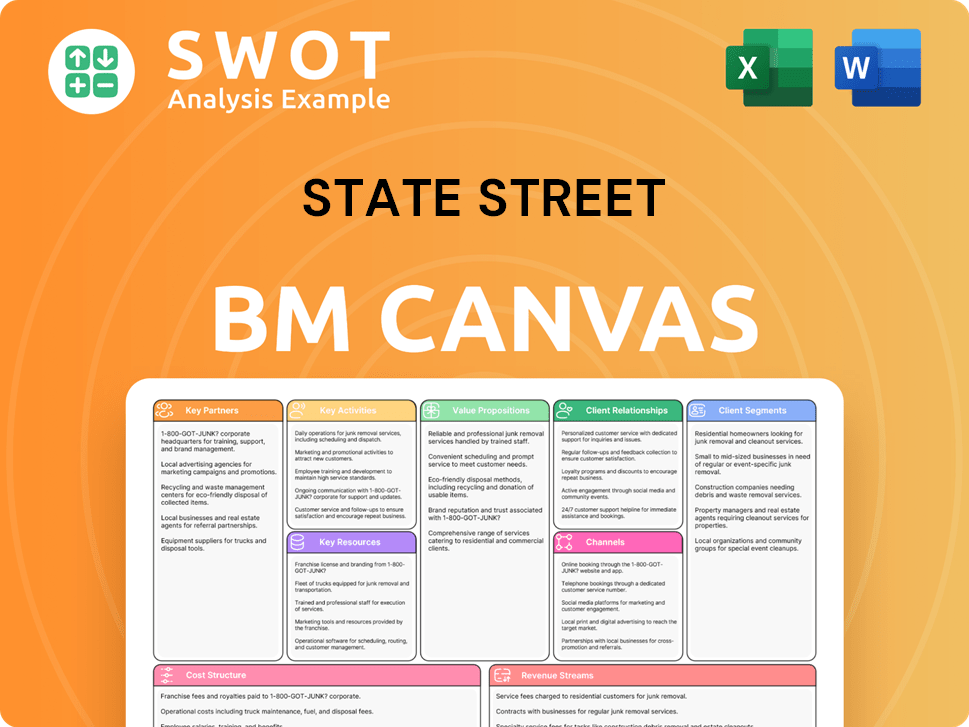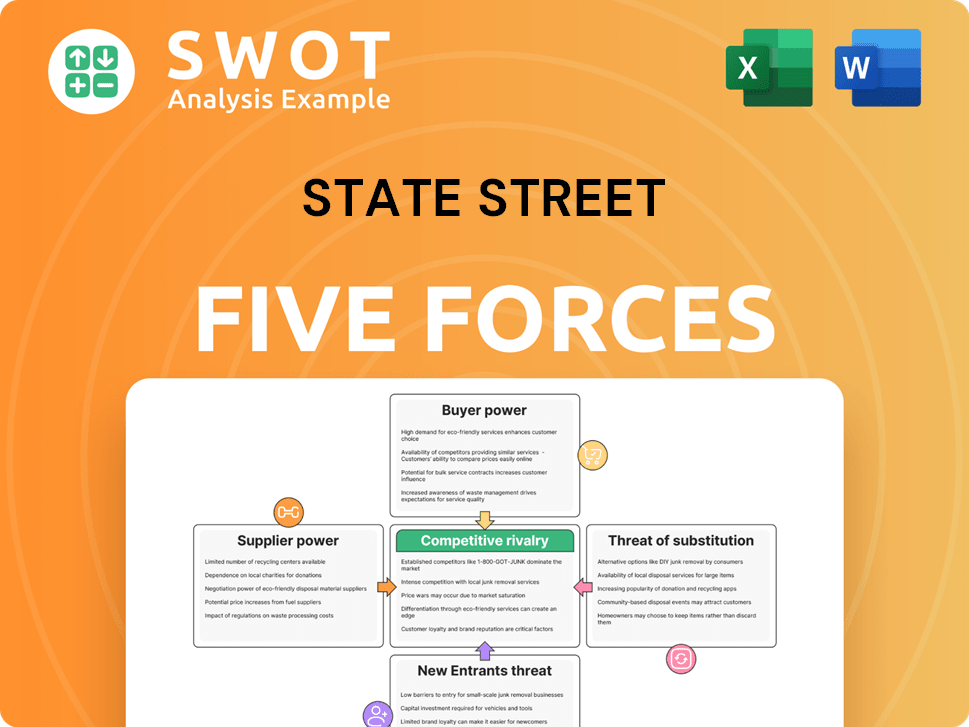State Street Bundle
How Does State Street Navigate the Ever-Changing Financial World?
State Street Corporation, a cornerstone of the global financial system since 1792, operates in the shadows yet significantly impacts investment ecosystems worldwide. As of early 2025, it faces a complex environment shaped by technological advancements and evolving client needs. From its humble beginnings as a regional bank, State Street has evolved into a global financial powerhouse.

To truly understand State Street's position, we must analyze its State Street SWOT Analysis, competitive landscape, and key rivals within the financial services industry. This involves a comprehensive State Street market analysis, evaluating its strengths, weaknesses, and strategic moves. Delving into State Street's competitive environment reveals its challenges and opportunities within the asset management companies sector, offering insights into its future outlook and competition within the global financial institutions arena.
Where Does State Street’ Stand in the Current Market?
State Street holds a significant position within the financial services industry, particularly as a leading custodian bank and asset servicer. The company's core operations revolve around investment servicing, investment management, and investment research and trading. This makes it a key player in the State Street competitive landscape, serving a diverse clientele that includes asset managers, pension funds, and insurance companies.
As of Q1 2025, State Street reported a substantial $43.9 trillion in assets under custody and/or administration (AUC/A) and $4.3 trillion in assets under management (AUM). These figures highlight its scale and influence among global financial institutions. State Street's value proposition lies in providing comprehensive financial solutions, from traditional custody services to advanced data analytics and front-to-back office solutions, adapting to the evolving needs of the financial sector.
The company's extensive geographic presence across the Americas, Europe, and Asia Pacific further solidifies its global reach. State Street's ability to offer integrated services and its strategic shift towards digital transformation have been crucial in maintaining its competitive edge. For a deeper dive into their business model, you can refer to Revenue Streams & Business Model of State Street.
State Street is among the largest players globally in the institutional financial services sector. Its substantial AUC/A and AUM figures underscore its significant market share. The company's size allows it to serve a broad range of clients and offer a wide array of services.
State Street's key business segments include investment servicing, investment management, and investment research and trading. Investment servicing encompasses custody, fund accounting, and transfer agency services. Investment management is primarily conducted through State Street Global Advisors.
State Street has a global presence with operations across the Americas, Europe, and Asia Pacific. This wide geographic reach allows the company to serve clients worldwide and capitalize on international market opportunities. This extensive reach is a key aspect of its competitive advantage.
Despite market volatility, State Street demonstrated robust financial health, reporting a net income of $702 million for Q1 2025. This performance reflects the company's ability to navigate challenges and maintain profitability. This financial strength is crucial for its long-term sustainability.
State Street's competitive advantages include its scale, global presence, and comprehensive service offerings. The company's ability to provide integrated solutions and adapt to digital transformation further enhances its position within the financial services industry. This includes its strong position in North America and Europe, serving a significant portion of the institutional investor base.
- Leading Custodian Bank: State Street's role as a leading custodian bank is a significant strength.
- Global Reach: Operations across the Americas, Europe, and Asia Pacific provide a broad market presence.
- Integrated Solutions: Offering front-to-back office solutions and data analytics enhances its value proposition.
- Financial Performance: Reporting a net income of $702 million in Q1 2025 indicates robust financial health.
State Street SWOT Analysis
- Complete SWOT Breakdown
- Fully Customizable
- Editable in Excel & Word
- Professional Formatting
- Investor-Ready Format

Who Are the Main Competitors Challenging State Street?
The Brief History of State Street reveals that State Street operates within a highly competitive financial services industry, facing rivals across its key business segments. Understanding the State Street competitive landscape is crucial for assessing its market position and future prospects. This analysis delves into the primary competitors and the competitive dynamics shaping State Street's performance.
State Street's competitive environment is characterized by a mix of established global financial institutions and emerging fintech firms. The company's market share analysis reveals the challenges and opportunities it faces in maintaining its position. The competitive landscape is constantly evolving due to technological advancements, mergers, and acquisitions, influencing how State Street competes in the global market.
State Street's key business segments include investment servicing and custody, and investment management. In the investment servicing and custody sector, State Street's main rivals are BNY Mellon, JPMorgan Chase, and Citigroup. These firms offer similar services, competing on pricing, technology, and the breadth of their service offerings. For example, BNY Mellon reported $48.8 trillion in assets under custody and/or administration as of Q1 2025, highlighting the intense competition in this segment.
BNY Mellon, JPMorgan Chase, and Citigroup are the primary competitors in this segment. These firms compete on pricing, technology, and the range of services offered. JPMorgan Chase leverages its extensive banking network and technological investments to attract clients.
BlackRock, Vanguard, and Fidelity are key competitors in the investment management arena. These firms compete on investment performance, product innovation, and brand recognition. BlackRock's iShares ETF platform is a dominant force.
Competitors use various strategies, including competitive pricing, technological advancements, and integrated service offerings. Fintech firms are also disrupting the market with specialized solutions. Mergers and acquisitions further reshape the competitive dynamics.
The competitive landscape is dynamic, with firms vying for market share through various strategies. State Street's market share analysis highlights its position relative to its competitors. The entry of new players and technological advancements continuously reshape the competitive environment.
Fintech firms are disrupting the traditional financial services industry by offering specialized solutions. These firms leverage technology such as blockchain, data analytics, and AI to provide innovative services. The rise of fintech adds another layer of competition.
Mergers and acquisitions are reshaping the competitive landscape. Larger banks acquire smaller tech firms to expand their capabilities and market reach. These strategic moves alter the competitive dynamics and influence State Street's position.
In the investment management arena, State Street Global Advisors (SSGA) competes with BlackRock, Vanguard, and Fidelity. BlackRock, with its iShares ETF platform, is a dominant force, while Vanguard is known for its low-cost index funds. Fidelity offers a broad spectrum of active and passive investment solutions. These firms compete through investment performance, product innovation, and brand recognition. The competitive landscape also includes emerging players, particularly in fintech, offering specialized solutions.
- BNY Mellon: Focuses on custody and asset servicing, competing on scale and global reach.
- JPMorgan Chase: Leverages its extensive banking network and technological investments to attract institutional clients.
- Citigroup: Competes through its global securities services arm, offering asset servicing solutions.
- BlackRock: Dominates with its iShares ETF platform, focusing on investment performance and product innovation.
- Vanguard: Known for its low-cost index funds, competing on cost-effectiveness.
- Fidelity: Offers a broad spectrum of active and passive investment solutions, competing on product diversity.
State Street PESTLE Analysis
- Covers All 6 PESTLE Categories
- No Research Needed – Save Hours of Work
- Built by Experts, Trusted by Consultants
- Instant Download, Ready to Use
- 100% Editable, Fully Customizable

What Gives State Street a Competitive Edge Over Its Rivals?
Understanding the competitive landscape of State Street involves examining its key advantages. The company has built a strong position in the financial services industry. This position is supported by its significant scale and specialized expertise. A look at Target Market of State Street can provide more insights into the company's strategic focus.
State Street's competitive edge is evident in its extensive global network and long-standing client relationships. Its ability to offer integrated solutions and adapt to regional regulatory nuances is also important. These factors contribute to its ability to serve a diverse international client base effectively. The company's focus on innovation and data-driven insights is critical for maintaining its competitive position.
As of Q1 2025, State Street's assets under custody and/or administration (AUC/A) reached $43.9 trillion. This massive scale provides significant economies of scale. This, in turn, enables cost efficiencies and substantial investments in technology and infrastructure. This scale acts as a major barrier to entry for new competitors. The company's proprietary technology platforms, like State Street Alpha, provide integrated front-to-back office solutions. This offers a comprehensive and seamless experience, differentiating it from rivals offering fragmented services.
State Street's vast scale, with $43.9 trillion in AUC/A as of Q1 2025, is a primary competitive advantage. This scale allows for cost efficiencies and significant investments in technology. The company's global distribution network also enables it to serve a diverse international client base.
Proprietary technology platforms, such as State Street Alpha, offer integrated solutions. These solutions provide a seamless experience for institutional clients. Continuous innovation in data analytics and risk management enhances its service offerings.
Strong brand equity and long-standing client relationships foster customer loyalty. State Street's reputation as a reliable custodian bank is crucial. The company's experience of over two centuries builds trust and stability.
State Street leverages its talent pool, especially in data analytics and risk management. This expertise allows it to provide sophisticated insights and solutions. This helps in maintaining a competitive edge in the financial services industry.
State Street's competitive advantages include its vast scale, advanced technology, and strong client relationships. These strengths are critical in the global financial market. The company's focus on innovation and client service helps it to maintain a strong position.
- Extensive scale and market presence with $43.9 trillion in AUC/A (Q1 2025).
- Proprietary technology platforms for integrated solutions.
- Strong brand equity and long-standing client relationships.
- Expertise in data analytics and risk management.
State Street Business Model Canvas
- Complete 9-Block Business Model Canvas
- Effortlessly Communicate Your Business Strategy
- Investor-Ready BMC Format
- 100% Editable and Customizable
- Clear and Structured Layout

What Industry Trends Are Reshaping State Street’s Competitive Landscape?
The institutional financial services industry is undergoing significant transformation, creating both challenges and opportunities for State Street. The Marketing Strategy of State Street must adapt to technological advancements, regulatory changes, and evolving client demands. The competitive landscape for State Street is dynamic, influenced by global economic shifts and the emergence of new market entrants. A thorough understanding of these trends is crucial for assessing State Street's competitive position and future prospects.
State Street's competitive landscape is shaped by its position within the global financial services industry. This includes a focus on asset servicing, asset management, and data & analytics services. State Street faces competition from established global financial institutions and specialized firms. The company's ability to innovate, adapt to regulatory changes, and capitalize on emerging market opportunities will determine its success in the evolving financial environment.
Technological advancements are driving significant changes, with AI, blockchain, and cloud computing transforming operations. Regulatory changes, including data privacy and cybersecurity, increase compliance costs. Evolving client preferences demand more transparent and digitally-enabled services. Global economic shifts, such as interest rate fluctuations, impact asset valuations.
Keeping pace with rapid technological evolution and integrating innovations is a continuous challenge. Increased compliance costs and operational complexities arise from regulatory changes. Aggressive fintech entrants and traditional rivals expanding digital capabilities pose threats. Pressure on fees for traditional asset servicing remains a constant concern. Managing geopolitical instability and inflation impacts.
Emerging markets offer significant expansion avenues as institutional investment grows. Product innovations, particularly in ESG investing and alternative assets, create new revenue streams. Strategic partnerships with technology firms or other financial institutions can enhance service offerings and market reach. Digital transformation and operational efficiency improvements are key strategies.
State Street is focusing on digital transformation to enhance its services. It is optimizing operational efficiency to reduce costs and improve service delivery. Expanding front-to-back office solutions provides more holistic value to clients. Adapting to market trends and capitalizing on opportunities is crucial for maintaining a competitive edge.
State Street's competitive landscape is influenced by its ability to adapt to technological advancements and regulatory changes. The company must navigate the evolving demands of institutional clients and the emergence of new competitors. The company's strategic responses, including digital transformation and operational efficiency, will determine its future performance. In 2024, State Street's revenue was approximately $12.6 billion, reflecting its position in a competitive market.
- Digital Transformation: Implementing AI, blockchain, and cloud technologies to improve efficiency and client services.
- Regulatory Compliance: Adapting to changes in data privacy, cybersecurity, and capital requirements.
- Market Expansion: Capitalizing on growth in emerging markets and product innovation in areas like ESG.
- Strategic Partnerships: Collaborating with technology firms and other financial institutions to enhance service offerings.
State Street Porter's Five Forces Analysis
- Covers All 5 Competitive Forces in Detail
- Structured for Consultants, Students, and Founders
- 100% Editable in Microsoft Word & Excel
- Instant Digital Download – Use Immediately
- Compatible with Mac & PC – Fully Unlocked

Related Blogs
- What are Mission Vision & Core Values of State Street Company?
- What is Growth Strategy and Future Prospects of State Street Company?
- How Does State Street Company Work?
- What is Sales and Marketing Strategy of State Street Company?
- What is Brief History of State Street Company?
- Who Owns State Street Company?
- What is Customer Demographics and Target Market of State Street Company?
Disclaimer
All information, articles, and product details provided on this website are for general informational and educational purposes only. We do not claim any ownership over, nor do we intend to infringe upon, any trademarks, copyrights, logos, brand names, or other intellectual property mentioned or depicted on this site. Such intellectual property remains the property of its respective owners, and any references here are made solely for identification or informational purposes, without implying any affiliation, endorsement, or partnership.
We make no representations or warranties, express or implied, regarding the accuracy, completeness, or suitability of any content or products presented. Nothing on this website should be construed as legal, tax, investment, financial, medical, or other professional advice. In addition, no part of this site—including articles or product references—constitutes a solicitation, recommendation, endorsement, advertisement, or offer to buy or sell any securities, franchises, or other financial instruments, particularly in jurisdictions where such activity would be unlawful.
All content is of a general nature and may not address the specific circumstances of any individual or entity. It is not a substitute for professional advice or services. Any actions you take based on the information provided here are strictly at your own risk. You accept full responsibility for any decisions or outcomes arising from your use of this website and agree to release us from any liability in connection with your use of, or reliance upon, the content or products found herein.